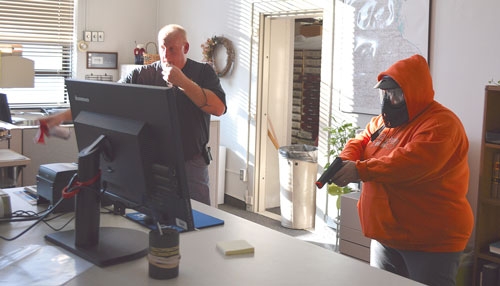You are here
Home ›Allamakee County Courthouse employees undergo ALICE Training in defense of "single-killer" event

Allamakee County Sheriff Clark Mellick (left in above photo) supervises a volunteer "gunman" in a simulated attack on the Allamakee County Courthouse during a training session to prepare courthouse employees for the possibility of a "single-killer situation." The ALICE training (Alert, Lockdown, Inform, Counter, Evacuate) conducted at the courthouse emphasizes taking action in such situations rather than just waiting for law enforcement to arrive at the scene. Standard photo and report by Bob Beach.
by Bob Beach
Allamakee County Sheriff Clark Mellick recently led employees at the Allamakee County Courthouse in an afternoon of training and instruction on how to handle what Mellick called a "single-killer situation." Mellick said that such situations had previously been referred to as "single-shooter situations," but recent attacks with knives changed that. He told the group that until recently, the standard response to a mass shooting situation had been to lock everyone down, hiding under desks, until law enforcement could arrive.
Mellick said that the training given to courthouse employees takes into account the motives of mass killers, the natural instincts of bystanders and the reality of law enforcement response time. The result is a response system (as opposed to response plan) to reduce casualties. The training program has been named ALICE, which stands for Alert, Lockdown, Inform, Counter, Evacuate.
"A" IS FOR ALERT
The first component of the ALICE system is to alert as many people as possible about the dangerous situation. This could be as simple as shouting something like "Gunman on the second floor!" Obviously, making everyone aware of the situation could result in fewer casualties if those in other areas of the building have time to respond, by making themselves inaccessible to the killer, either by locking down in place or by exiting the building.
"L" IS FOR LOCKDOWN
In situations where escaping the building or area under attack is not possible, Mellick said that the best course of action may be to lock or barricade doors and hide. He added, however, that the response should not be limited to that. "If you are in the same room with the killer, you need to be ready to fight for your life," Mellick said.
"I" IS FOR INFORM
Mellick told the group that throughout the situation, it's important to keep both law enforcement and others in the building informed about the location of the attacker and his or her movements.
"C" IS FOR COUNTER
Contrary to the common response of locking down and waiting for law enforcement, Mellick suggested that there are things that employees and bystanders can do to reduce casualties by distracting, frustrating or otherwise slowing the attacker's goal, which should be presumed to be killing as many people as possible before law enforcement arrives. Simple things like shouting or throwing objects could distract a killer enough to buy time before law enforcement arrives on the scene, thereby saving lives. Group swarming and disarming the attacker was also discussed as a possible response.
"E" IS FOR EVACUATE
The most important aspect of the ALICE training is to encourage potential victims to evacuate the area under attack whenever possible. The actions of others may provide valuable information about the location and actions of the killer in order to facilitate an evacuation of the building. Mellick said that because it could take from six to ten minutes for law enforcement to arrive on the scene, it's important that bystanders don't "wait for the calvary."
Mellick told the group that the most important aspect of the training is to let people know that they can and should take action to save themselves and others in a single killer situation. "If you can run, run," he said, "Do something. Don't just wait."

